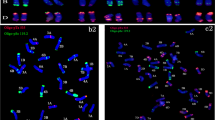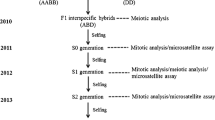Abstract
Modern wheat cultivars can benefit from useful variability introduced from non-progenitor Aegilops species by using synthetic partial amphiploids. Cytological analysis of advanced generation wheat-Aegilops amphiploids (AABBDDUkUkSkSk) had 54–58 chromosomes in general with a higher frequency of bivalents (24.0–27.97). The average number of univalents in pollen mother cells (PMCs) varied from 1.32–5.28 with an average of 2.29 per cell. After the reductional division of paired chromosomes, the majority of univalents reached the metaphase-I plate and underwent equational division, eventually being eliminated via laggards and micronuclei. The D genome was the most vulnerable to deletion, followed by the Sk and Uk genomes, but the 1D chromosome was preferentially eliminated in almost all amphiploids investigated, as confirmed by SDS-PAGE. The partial amphiploids with white glumes, bold seeds, and robust rachis could be employed for wheat biofortification and resistance to powdery mildew. The presence of various important metal homeostasis genes (FRO2, FRO6, FRO7, ZIP2, ZIP4, ZIP5, ZIP7, NAS2, NAS4, YSL15, IRT2, NRAMP5, NAM, and HMA3) from Aegilops species suggests that these partial amphiploids could be used as pre-bred material to introgress the metal homeostasis genes from Aegilops to wheat in wheat biofortification program.




Similar content being viewed by others
Abbreviations
- SSR:
-
Simple Sequence Repeats
- ITAP:
-
Intron Targeted Amplified Polymorphic
- HMWGS:
-
High Molecular Weight Glutenin Subunits
- PBW343 LrP :
-
PBW343 (Lr24 + GPC B1)
References
Aghaee-Sarbarzeh M, Ferrahi M, Singh S, Singh H, Friebe B, Gill BS et al (2002) PhI-induced transfer of leaf and stripe rust-resistance genes from Aegilops triuncialis and Ae. geniculata to bread wheat. Euphytica 127:377–382
Almouslem A, Jauhar P, Peterson T, Bommineni V, Rao M (1998) Haploid durum wheat production via hybridization with maize. Crop Sci 38:1080–1087
Barclay I (1975) High frequencies of haploid production in wheat (Triticum aestivum) by chromosome elimination. Nature 256:410–411
Bohn L, Meyer AS, Rasmussen SK (2008) Phytate: impact on environment and human nutrition. A challenge for molecular breeding. J Zhejiang Univ Sci B 9:165–191. https://doi.org/10.1631/jzus.B0710640
Ceresini PC, Castroagudín VL, Rodrigues FÁ, Rios JA, Aucique Pérez CE, Moreira SI et al (2019) Wheat blast: from its origins in South America to its emergence as a global threat. Molecular Plant Path 20:155–172
Chen P, Tsujimoto H, Gill BS (1994) Transfer of PhI genes promoting homoeologous pairing from Triticum speltoides to common wheat. Theor Appl Genet 88:97–101
Cheng ZJ, Murata M (2002) Loss of chromosomes 2R and 5RS in octoploid triticale selected for agronomic traits. Genes Genet Syst 77:23–29
Cruz C, Peterson G, Bockus W, Kankanala P, Dubcovsky J, Jordan K et al (2016) The 2NS translocation from Aegilops ventricosa confers resistance to the Triticum pathotype of Magnaporthe oryzae. Crop Sci 56:990
Dvořák J, Terlizzi Pd, Zhang HB, Resta P (1993) The evolution of polyploid wheats: identification of the A genome donor species. Genome 36:21–31
Faris J, Friebe B, Gill B (2002) Wheat genomics: exploring the polyploid model. Curr Genomics 3:577–591
Ficco D, Riefolo C, Nicastro G, De Simone V, Di Gesu A, Beleggia R et al (2009) Phytate and mineral elements concentration in a collection of Italian durum wheat cultivars. Field Crops Res 111:235–242
Garg M, Elamein HM, Tanaka H, Tsujimoto H (2007) Preferential elimination of chromosome 1D from homoeologous group-1 alien addition lines in hexaploid wheat. Genes Genet Sys 82:403–408
Gernand D, Rutten T, Varshney A, Rubtsova M, Prodanovic S, Brüß C et al (2005) Uniparental chromosome elimination at mitosis and interphase in wheat and pearl millet crosses involves micronucleus formation, progressive heterochromatinization, and DNA fragmentation. Plant Cell 17:2431–2438
Han F, Fedak G, Guo W, Liu B (2005) Rapid and repeatable elimination of a parental genome-specific DNA repeat (pGc1R-1a) in newly synthesized wheat allopolyploids. Genetics 170:1239–1245. https://doi.org/10.1534/genetics.104.039263
Jauhar P, Dogramaci-Altuntepe M, Peterson T, Almouslem A (2000) Seed set on synthetic haploids of durum wheat: cytological and molecular investigations. Crop Sci 40:1742–1749
Jiang J, Friebe B, Gill BS (1993) Recent advances in alien gene transfer in wheat. Euphytica 73:199–212
Johnson HW, Robinson HF, Comstock RE (1955) Estimates of genetic and environmental variability in soybean. Agron J 47:314–318
Jorhem L, Engman J (2000) Determination of lead, cadmium, zinc, copper, and iron in foods by atomic absorption spectrometry after microwave digestion: NMKL1 collaborative study. J AOAC Int 83:1189–1203
Jorhem L, Engman J, Collaborators: (2019) Determination of lead, cadmium, zinc, copper, and iron in foods by atomic absorption spectrometry after microwave digestion: NMKL1 collaborative study. Journal of AOAC International 83:1189–1203 https://doi.org/10.1093/jaoac/83.5.1189
Kihara H (1944) Discovery of the DD-analyser, one of the ancestors of Triticum vulgare. Agric Hort 19:13–14
Kishii M (2019) An update of recent use of Aegilops Species in wheat breeding. Front Plant Sci. https://doi.org/10.3389/fpls.2019.00585
Koba T, Handa T, Shimada T (1991) Efficient production of wheat-barley hybrids and preferential elimination of barley chromosomes. Theor Appl Genet 81:285–292
Kumar A, Rani P, Purohit SR, Rao PS (2020) Effect of ultraviolet irradiation on wheat (Triticum aestivum) flour: study on protein modification and changes in quality attributes. Journal of Cereal Sci 96:103094
Leath S, Heun M (1990) Identification of powdery mildew resistance genes in cultivars of soft red winter wheat. Plant Dis 74:747–752
Li F, Wen W, He Z, Liu J, Jin H, Cao S et al (2018) Genome-wide linkage mapping of yield-related traits in three Chinese bread wheat populations using high-density SNP markers. Theor Appl Genet 131:1903–1924
Lyusikov O, Bel’ko N, Shchet’ko I, Gordei I (2005) Construction of rye-wheat amphidiploids with the cytoplasm of rye-Secalotriticum (RRAABB, 2n= 42): meiosis characteristics in rye-triticale F1 hybrids (RRABR, 5x= 35). Russian J Genet 41:735–741
Mahalanobis PC (1928) A statistical study at Chinese head measurement. J Asiat Soc Bengal 25:301–377
McFadden ES, Sears ER (1946) The origin of Triticum spelta and its free-threshing hexaploid relatives. J Hered 37:81–89
McIntosh R, Dubcovsky J, Rogers JW, Morris C, Appels R, Xia X (2014) Catalogue of gene symbols for wheat: 2013–14 Supplement. Ann Wheat Newsletter 58
Mecha B, Alamerew S, Assefa A, Dutamo D, Assefa E (2017) Correlation and path coefficient studies of yield and yield associated traits in bread wheat (Triticum aestivum L.) genotypes. Adv Plants Agric Res 6:1–10
Mujeeb-Kazi A, Gul A, Farooq M, Rizwan S, Tabassum S, Bux H et al (2007) Cytogenetics of some Triticum aestivum and T. turgidum x Aegilops variabilis intergeneric hybrids and their derived amphiploids. Pak J Bot 39:415
Murray M, Thompson WF (1980) Rapid isolation of high molecular weight plant DNA. Nuc Acids Res 8:4321–4326
Neelam K, Rawat N, Tiwari VK, Kumar S, Chhuneja P, Singh K et al (2011) Introgression of group 4 and 7 chromosomes of Ae. peregrina in wheat enhances grain iron and zinc density. Mol Breed 28:623–634
Oliver R, Xu S, Stack R, Friesen T, Jin Y, Cai X (2006a) Molecular cytogenetic characterization of four partial wheat-Thinopyrum ponticum amphiploids and their reactions to Fusarium head blight, tan spot, and Stagonospora nodorum blotch. Theor Appl Genet 112:1473–1479
Park C, Walton P (1989) Embryo-callus-regenerated hybrids and their colchicine-induced amphiploids between Elymus canadensis and Secale cereale. Theor Appl Genet 78:721–727
Peleg Z, Saranga Y, Yazici A, Fahima T, Ozturk L, Cakmak I (2008) Grain zinc, iron and protein concentrations and zinc-efficiency in wild emmer wheat under contrasting irrigation regimes. Plant Soil 306:57–67
Pestsova E, Ganal M, Röder M (2000) Isolation and mapping of microsatellite markers specific for the D genome of bread wheat. Genome 43:689–697
Peterson RF, Campbell A, Hannah A (1948) A diagrammatic scale for estimating rust intensity on leaves and stems of cereals. Canadian J Res 26:496–500
Rawat N, Tiwari VK, Neelam K, Randhawa GS, Chhuneja P, Singh K et al (2009a) Development and characterization of Triticum aestivum–Aegilops kotschyi amphiploids with high grain iron and zinc contents. Plant Genet Res 7:271–280
Rawat N, Tiwari VK, Singh N, Randhawa GS, Singh K, Chhuneja P et al (2009b) Evaluation and utilization of Aegilops and wild Triticum species for enhancing iron and zinc content in wheat. Genet Res Crop Evol 56:53
Rawat N, Neelam K, Tiwari VK, Randhawa GS, Friebe B, Gill BS et al (2011) Development and molecular characterization of wheat–Aegilops kotschyi addition and substitution lines with high grain protein, iron, and zinc. Genome 54:943–953
Riley R, Unrau J, Chapman V (1958) Evidence on the origin of the B genome of wheat. J Hered 49:91–98
Robinson HF, Comstock RE, Harvey PH (1949) Estimates of heritability and the degree of dominance in corn. Agron J 41:353–359
Röder MS, Korzun V, Wendehake K, Plaschke J, Tixier MH, Leroy P et al (1998) A microsatellite map of wheat. Genetics 149:2007–2023
Sachs L (1952) Chromosome mosaics in experimental amphiploids in the Triticinae. Hered 6:157–170
Schneider A, Molnár I, Molnár-Láng M (2008) Utilisation of Aegilops (goatgrass) species to widen the genetic diversity of cultivated wheat. Euphytica 163:1–19
Sharma P, Sheikh I, Singh D, Kumar S, Verma SK, Kumar R et al (2017) Uptake, distribution, and remobilization of iron and zinc among various tissues of wheat–Aegilops substitution lines at different growth stages. Acta Physiol Plant 39:185
Sheikh I, Sharma P, Verma SK, Kumar S, Kumar N, Kumar S, Kumar R, Vyas P, Dhaliwal HS (2018) Development of intron targeted amplified polymorphic markers of metal homeostasis genes for monitoring their introgression from Aegilops species to wheat. Mol Breed 38:47. https://doi.org/10.1007/s11032-018-0809-y
Shi M, Lam TTY, Hon CC, Hui RKH, Faaberg KS, Wennblom T et al (2010) Molecular epidemiology of PRRSV: a phylogenetic perspective. Virus Res 154:7–17
Somers DJ, Isaac P, Edwards K (2004) A high-density microsatellite consensus map for bread wheat (Triticum aestivum L.). Theor Appl Genet 109:1105–1114
Steel RGD, Torrie JH (1980) Principles and procedures of statistics. A biometrical approach, 2nd edn, McGraw-Hill Book Company, New York, USA, pp 20–90
Tiwari VK, Rawat N, Neelam K, Randhawa GS, Singh K, Chhuneja P et al (2008) Development of Triticum turgidum subsp. durum-Aegilops longissima amphiploids with high iron and zinc content through unreduced gamete formation in F1 hybrids. Genome 51:757–766
Velu G, Singh RP, Crespo-Herrera L, Juliana P, Dreisigacker S, Valluru R et al (2018) Genetic dissection of grain zinc concentration in spring wheat for mainstreaming biofortification in CIMMYT wheat breeding. Scientific Rep 8:1–10
Walker-Smith D, Payne J (1984) Characteristics of the active transport of peptides and amino acids by germinating barley embryos. Planta 162:159–165
Welch RM (2002) Breeding strategies for biofortified staple plant foods to reduce micronutrient malnutrition globally. J Nutr 132:495S-499S
Welch RM, Graham RD (2004) Breeding for micronutrients in staple food crops from a human nutrition perspective. J Exp Bot 55:353–364
Zhao Q, Jiang Q, Yang Q, Ma J, Wang J, Chen G et al (2014) Characterization of intergeneric hybrid between common wheat and Aegilops sharonensis (Eig) and transfer of alien high molecular weight glutenin subunits into wheat. Cereal Res Commun 42:640–647
Acknowledgements
The financial support provided by the Department of Biotechnology (DBT), Government of India (BT/NABI-Flagship/2018) is duly acknowledged. The authors also acknowledge Dr. Khem Singh Gill Akal College of Agriculture for providing the necessary infrastructure and research facilities for carrying out this work.
Author information
Authors and Affiliations
Corresponding author
Ethics declarations
Conflict of interest
The authors declare that they have no conflict of interest.
Human or animal rights
This article does not contain any studies with human participants or animals performed by any of the authors.
Additional information
Publisher's Note
Springer Nature remains neutral with regard to jurisdictional claims in published maps and institutional affiliations.
Supplementary Information
Below is the link to the electronic supplementary material.
Rights and permissions
Springer Nature or its licensor (e.g. a society or other partner) holds exclusive rights to this article under a publishing agreement with the author(s) or other rightsholder(s); author self-archiving of the accepted manuscript version of this article is solely governed by the terms of such publishing agreement and applicable law.
About this article
Cite this article
Kaur, R., Kaur, H., Saini, P. et al. Cytological, biochemical and molecular characterization of Triticum-Aegilops amphiploids. J. Plant Biochem. Biotechnol. 32, 375–387 (2023). https://doi.org/10.1007/s13562-022-00817-x
Received:
Accepted:
Published:
Issue Date:
DOI: https://doi.org/10.1007/s13562-022-00817-x




